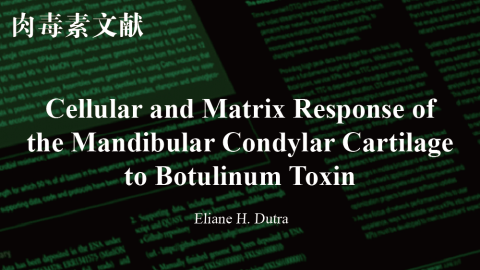
- 3178人
- 分享收藏
Cellular and Matrix Response of the Mandibular Condylar Cartilage to Botulinum Toxin
Eliane H. Dutra
简介
【 文献重点摘要 】
Objectives
To evaluate the cellular and matrix effects of botulinum toxin type A (Botox) on mandibular condylar cartilage (MCC) and subchondral bone.
Materials and Methods
Botox (0.3 unit) was injected into the right masseter of 5-week-old transgenic mice (Col10a1-RFPcherry) at day 1. Left side masseter was used as intra-animal control. The following bone labels were intraperitoneally injected: calcein at day 7, alizarin red at day 14 and calcein at day 21. In addition, EdU was injected 48 and 24 hours before sacrifice. Mice were sacrificed 30 days after Botox injection. Experimental and control side mandibles were dissected and examined by x-ray imaging and micro-CT. Subsequently, MCC along with the subchondral bone was sectioned and stained with tartrate resistant acid phosphatase (TRAP), EdU, TUNEL, alkaline phosphatase, toluidine blue and safranin O. In addition, we performed immunohistochemistry for pSMAD and VEGF.
Results
Bone volume fraction, tissue density and trabecular thickness were significantly decreased on the right side of the subchondral bone and mineralized cartilage (Botox was injected) when compared to the left side. There was no significant difference in the mandibular length and condylar head length; however, the condylar width was significantly decreased after Botox injection. Our histology showed decreased numbers of Col10a1 expressing cells, decreased cell proliferation and increased cell apoptosis in the subchondral bone and mandibular condylar cartilage, decreased TRAP activity and mineralization of Botox injected side cartilage and subchondral bone. Furthermore, we observed reduced proteoglycan and glycosaminoglycan distribution and decreased expression of pSMAD 1/5/8 and VEGF in the MCC of the Botox injected side in comparison to control side.
Conclusion
Injection of Botox in masseter muscle leads to decreased mineralization and matrix deposition, reduced chondrocyte proliferation and differentiation and increased cell apoptosis in the MCC and subchondral bone.
目的
探讨A型肉毒毒素(Botox)对下颌骨髁状突软骨(MCC)和软骨下骨的细胞和基质影响。
材料与方法
5周龄转基因小鼠(Col10a1-RFPcherry)第1天右侧咬肌内注射肉毒杆菌0.3个单位,左侧咬肌作为动物内对照。腹腔注射下列骨标记物:钙黄素在第7天,茜素红在第14天,钙黄素在第21天。此外,EDU在牺牲前48小时和24小时被注射。注射肉毒杆菌后30天处死小鼠。解剖实验侧和对照侧下颌骨,进行X线影像和显微CT检查。取MCC及软骨下骨,行抗酒石酸酸性磷酸酶(TRAP)、EDU、TUNEL、碱性磷酸酶、甲苯胺蓝和藏红花O染色,并进行pSMAD和VEGF免疫组织化学染色。
结果
注射肉毒杆菌后,右侧软骨下骨和矿化软骨的骨体积分数、组织密度和骨小梁厚度均较左侧明显降低。注射肉毒杆菌后,下颌骨长度和髁状突头长无明显差异,但髁突宽度明显减小。组织学显示软骨下骨和下颌髁突软骨中Col10a1表达的细胞数量减少,细胞增殖减少,细胞凋亡增加,注射肉毒杆菌的侧软骨和软骨下骨的TRAP活性和矿化程度降低。此外,我们观察到肉毒杆菌注射侧MCC中蛋白多糖和糖胺聚糖分布减少,pSMAD1/5/8和VEGF表达降低。
结论
咬肌内注射肉毒杆菌可导致MCC和软骨下骨的矿化和基质沉积减少,软骨细胞增殖和分化减少,细胞凋亡增加。



